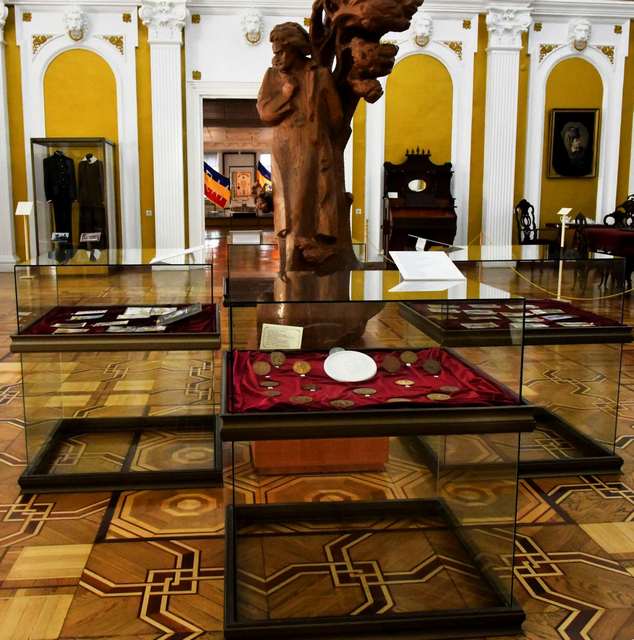
Mihai Eminescu, one of the most prominent figures of Romanian culture, is celebrated through an exceptional mini-exhibition hosted in the Bronze Hall of the National Museum of History of Moldova. This exhibition reveals a unique perspective on the national poet, reflected through objects of remarkable artistic and historical value. Items from the fields of medallic art, philately, and postcard collecting, each telling its own story, reconstruct the image of the poet in details that transcend time.
The exhibition atmosphere is marked by works created by talented artists from Moldova, Romania, Latvia, and Russia, each contributing their own interpretation of the Eminescian legacy. Among them stand out Constantin Dumitrescu, Vasile Gabor, Maximilian Fetița, Ștefan Grudinschi, Janis Strupulis, and Aleksandr Baklanov, whose creations offer an engaging insight into the poet's life and work. The exhibited medals evoke various themes, from the emblematic friendship with Ion Creangă, his study trips to Vienna, Berlin, and other European cultural centers, to the image of his parents, Gheorghe and Raluca Eminovici, who profoundly influenced his development. Engraved portraits of the poet, inspired by the four iconic photographs, complete this vibrant image.
A special place is occupied by rare pieces, such as the commemorative "1 ruble" coin issued in 1989 on the centenary of the poet's death, crafted by Aleksandr Baklanov at the Saint Petersburg Mint. Other medals, such as "The Eminescu Constellation," depicting the poet's family, and "The Signature of Poet M. Eminescu," offer personal details and symbols associated with him. Additionally, the series "Basarabia Grateful" brings into focus the connection between Eminescu's legacy and the community's gratitude for the cultural values perpetuated.
The postcards presented in the exhibition capture essential aspects of Mihai Eminescu's life and work through collectible postcards. These include portraits of the poet, illustrations inspired by his poems, images of iconic places linked to his life, as well as representations of busts of the poet and monuments erected in his memory. Each postcard becomes a visual testimony to the universal impact his creation had on national and international culture.
The philatelic items showcased bring to the forefront stamp sheets, individual stamps, and philatelic blocks that celebrate Eminescu's personality and work. They are illustrated with images of his family tree and prominent figures in his circle. Issued in Moldova, Romania, and other countries, these philatelic pieces not only reflect respect for the poet's work but also perpetuate his memory in a form accessible to collectors and art enthusiasts worldwide.
The exhibits come from both the museum's collection and donations from renowned collectors such as Ioan Dogaru, Nicolae Curdov, Constantin Dumitrescu, and others. This diversity reflects the profound impact of Eminescu's work on successive generations of creators and admirers. The postcards and stamp sheets contribute to completing the image of the poet, illustrating key moments of his life and evoking the universality of his poetic message.
The public is invited to discover this remarkable collection throughout the year, within an exhibition space that combines elegance with cultural reflection. Visitors will have the opportunity to contemplate the image of the national poet, reflected in artistic creations of inestimable value, which evoke the universal echo of his immortal work. The National Museum of History of Moldova invites you to explore a lesser-known aspect of Mihai Eminescu's legacy, a cultural treasure preserved and celebrated for all generations.
 31 August 1989 St., 121 A, MD 2012, Chisinau, Republic of Moldova
31 August 1989 St., 121 A, MD 2012, Chisinau, Republic of Moldova




 The side panels are elegantly decorated with refined cast-iron elements in the Art Nouveau style, displaying the brand name - "Ideal." The Polyglott model, featuring a bilingual keyboard patented in the United Kingdom by Max Klaczko from Riga, Latvia, was produced between 1902 and 1913, marking the first typewriter capable of writing in two languages. The "Ideal Polyglott" typewriter was actively sold in the Russian Empire and gained significant popularity in Poland, Bulgaria, and Serbia.
The side panels are elegantly decorated with refined cast-iron elements in the Art Nouveau style, displaying the brand name - "Ideal." The Polyglott model, featuring a bilingual keyboard patented in the United Kingdom by Max Klaczko from Riga, Latvia, was produced between 1902 and 1913, marking the first typewriter capable of writing in two languages. The "Ideal Polyglott" typewriter was actively sold in the Russian Empire and gained significant popularity in Poland, Bulgaria, and Serbia.






















































